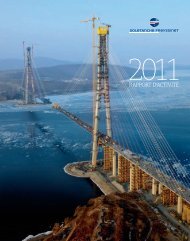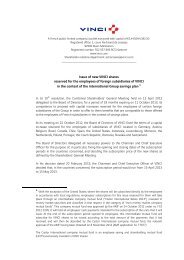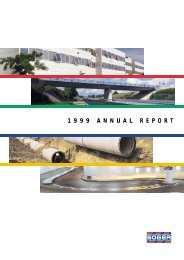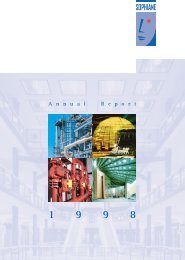VINCI - 2005 annual report
VINCI - 2005 annual report
VINCI - 2005 annual report
Create successful ePaper yourself
Turn your PDF publications into a flip-book with our unique Google optimized e-Paper software.
These estimates assume the operation is a going concern and are made<br />
on the basis of the information available at the time. Estimates may be<br />
revised if the circumstances on which they were based alter or if new<br />
information becomes available. Actual results may be different from these<br />
estimates.<br />
Revenue<br />
The consolidated revenue of the Energies, Roads and Construction business<br />
lines represents the total of the work, goods and services produced by the<br />
consolidated subsidiaries as their main activity. It includes the Group’s<br />
revenue from concession infrastructure shown in the <strong>VINCI</strong> balance sheet<br />
as concession intangible fixed assets. The method for recognising revenue<br />
in respect of construction contracts is explained in the note on construction<br />
contracts below.<br />
The Concession and services business line’s consolidated revenue comprises<br />
tolls for the use of road infrastructures operated under concessions,<br />
revenue booked by car parks and airport service concessions, and ancillary<br />
income such as fees for the use of commercial installations, rental of<br />
telecommunication infrastructure and advertising space.<br />
In the property sector, revenue arising on lots sold is recognised as the<br />
property development proceeds, using the incurred cost method (cost of<br />
land, of work, etc.).<br />
Revenue from ancillary activities<br />
Revenue from ancillary activities comprises rental income, sales of equipment,<br />
materials and merchandise, study work and fees other than those<br />
generated by concession operators.<br />
Construction contracts<br />
<strong>VINCI</strong> recognises construction contract income and expenses using the stage<br />
of completion method defined by IAS 11.<br />
For the Construction business line, the stage of completion is usually determined<br />
on a physical basis. For the other business lines (Roads and Energies),<br />
the stage of completion is determined on the basis of the percentage of total<br />
costs incurred to date.<br />
For construction projects in which <strong>VINCI</strong>’s share is less than €10 million, it is<br />
considered that the profit or loss recognised on the basis of work completed<br />
is in line with that determined on a stage of completion basis, other than in<br />
exceptional cases.<br />
If the estimate of the final outcome of a contract indicates a loss, a provision<br />
is made for the loss on completion regardless of the stage of completion, based<br />
on the best estimates of income, including any rights to additional revenue or<br />
claims if these are probable and can be reliably estimated. Provisions for losses<br />
on completion are shown under liabilities.<br />
Revenue, including the margin on the construction (profit or loss), realised<br />
in the context of concession contracts shown under concession intangible<br />
fixed assets is recorded in the income statement using the stage of completion<br />
method described above.<br />
Part-payments received under construction contracts before the corresponding<br />
work has been carried out are recognised under liabilities under advances and<br />
payments on account received.<br />
200<br />
<strong>VINCI</strong> <strong>2005</strong> ANNUAL REPORT<br />
Share-based payments<br />
The measurement and recognition methods for share subscription and<br />
purchase plans and the Plans d’Epargne Groupe – Group Savings Scheme<br />
– are defined by IFRS 2 Share-based Payment. The granting of share options<br />
and offers to subscribe to the Group Savings Scheme represent a benefit<br />
granted to their beneficiaries and therefore constitute supplementary<br />
remuneration borne by <strong>VINCI</strong>. Because such transactions do not give rise<br />
to monetary transactions, the benefits granted in this way are recognised<br />
as expenses in the period in which the rights are acquired, with a corresponding<br />
increase in equity. Benefits are measured on the basis of the fair<br />
value of the equity instruments granted.<br />
Share subscription option plans<br />
Options to subscribe to shares are granted to Group employees and officers.<br />
The fair value of the options granted is determined at the grant date<br />
using a binomial valuation model, of the “Monte Carlo” type, adjusting<br />
for the probability of the vesting conditions of the rights to exercise the<br />
option not being met.<br />
Group Savings Scheme<br />
Under the Group Savings Scheme, the Group issues new shares three times<br />
a year reserved for its employees with a subscription price that includes a<br />
discount against the average stock market price of the <strong>VINCI</strong> share during<br />
the last 20 business days preceding the authorisation by the Board of<br />
Directors. This discount is considered as a benefit granted to the employees;<br />
its fair value is determined using a binomial valuation model, of the<br />
“Monte Carlo” type, at the date on which the Board of Directors sets the<br />
subscription price. As certain restrictions apply to the shares acquired by<br />
the employees under these plans regarding their sale or transfer, the fair<br />
value of the benefit to the employee takes account of the fact that the shares<br />
acquired cannot be freely disposed of for five years.<br />
Cost of net financial debt<br />
The cost of net financial debt comprises:<br />
– the cost of gross financial debt, which includes the interest expense<br />
calculated at the effective interest rate, gains and losses on interest rate<br />
hedges in respect of gross financial debt, and net changes in the fair<br />
value of interest rate derivatives that are not used for hedging.<br />
– financial income from investments comprises the return on cash investments<br />
(interest income, dividends from UCITS, disposal gains and losses,<br />
etc.), the impact of interest rate hedges related to these investments and<br />
changes in their fair value.<br />
Other financial income and expenses<br />
Other financial income and expenses mainly comprise foreign exchange<br />
gains and losses, the effects of discounting to present value, dividends<br />
received from unconsolidated entities, capitalised borrowing costs and<br />
changes in the value of derivatives not allocated to interest rate risk<br />
management.<br />
Borrowing costs borne during the construction of assets are included in<br />
the cost of the assets. They are determined as follows:<br />
– to the extent that funds are borrowed specifically for the purpose of<br />
constructing an asset, the borrowing costs eligible for capitalisation on<br />
that asset are the actual borrowing costs incurred during the period less<br />
any investment income arising from the temporary investment of those<br />
borrowings;
















